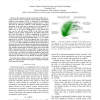Free Online Productivity Tools
i2Speak
i2Symbol
i2OCR
iTex2Img
iWeb2Print
iWeb2Shot
i2Type
iPdf2Split
iPdf2Merge
i2Bopomofo
i2Arabic
i2Style
i2Image
i2PDF
iLatex2Rtf
Sci2ools
108
click to vote
ICDM
2009
IEEE
2009
IEEE
Convex Non-negative Matrix Factorization in the Wild
Abstract—Non-negative matrix factorization (NMF) has recently received a lot of attention in data mining, information retrieval, and computer vision. It factorizes a non-negative input matrix V into two non-negative matrix factors V = WH such that W describes ”clusters” of the datasets. Analyzing genotypes, social networks, or images, it can be beneficial to ensure V to contain meaningful “cluster centroids”, i.e., to restrict W to be convex combinations of data points. But how can we run this convex NMF in the wild, i.e., given millions of data points? Triggered by the simple observation that each data point is a convex combination of vertices of the data convex hull, we propose to restrict W further to be vertices of the convex hull. The benefits of this convex-hull NMF approach are twofold. First, the expected size of the convex hull of, for example, n random Gaussian points in the plane is Ω( √ log n), i.e., the candidate set typically grows much slower than the dat...
Convex Hull | Convex Nmf | Data Mining | Data Point | ICDM 2009 |
Related Content
| Added | 23 May 2010 |
| Updated | 23 May 2010 |
| Type | Conference |
| Year | 2009 |
| Where | ICDM |
| Authors | Christian Thurau, Kristian Kersting, Christian Bauckhage |
Comments (0)

